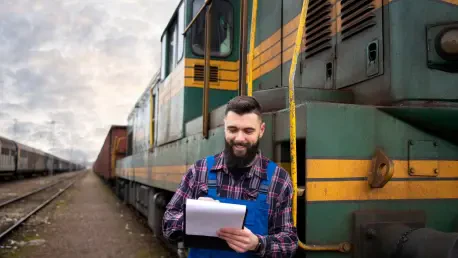In the fast-paced world of logistics and supply chain management, Rohit Laila stands out as a seasoned expert, passionately leading innovations in the sector. With a deep understanding of the industry dynamics and the latest trends, he shares his insights on Greenbrier’s compelling financial performance in the third quarter of 2025. His expertise reveals the strategic maneuvers and operational efficiencies that have positioned the company for ongoing success.
Can you elaborate on the key factors that contributed to Greenbrier’s strong financial performance in the third quarter of 2025?
Greenbrier’s impressive financial performance in the third quarter is linked to a combination of factors. First, there was a strong operational execution across all segments, which allowed us to leverage market opportunities effectively. We also focused on enhancing our gross margin by optimizing our geographical footprint and insourcing activities. Our strategic investments in the Leasing & Fleet Management segment played a significant role in building a reliable revenue stream. Together, these elements created a robust financial platform for Greenbrier.
How did you manage to exceed the mid-teens long-term target for your aggregate gross margin percent?
Exceeding the mid-teens long-term target was a concerted effort. We concentrated on operational efficiencies and strategic insourcing to reduce costs and streamline production processes. By expanding our presence in strategic locations like Mexico, we were able to cut down on logistics expenses and improve our cost structure. The disciplined approach across all business operations helped us achieve this significant milestone in our gross margin percent.
What specific operational initiatives were implemented to optimize Greenbrier’s footprint in Europe and expand insourcing in Mexico?
In Europe, we streamlined operations by closing a manufacturing facility as part of a joint venture and consolidated activities to reduce overhead costs. This move is expected to save us at least $10 million annually. In Mexico, we expanded insourcing to take advantage of lower production costs and closer proximity to key markets. These initiatives not only helped in optimizing our footprint but also improved our production lead times and cost-effectiveness.
Can you explain the role of the Leasing & Fleet Management segment in contributing to Greenbrier’s recurring revenue stream?
The Leasing & Fleet Management segment has been instrumental in generating steady revenue. By owning a robust fleet of 14,600 railcars, we have secured a continuous leasing income. This segment focuses on maintaining high utilization rates and delivering superior management services to our clients, which ensures a consistent influx of revenue while enhancing our clients’ operational efficiencies.
What were the main drivers behind the $60 million net earnings figure for the third quarter?
The $60 million net earnings were primarily driven by strong demand for new railcars and enhanced operational efficiencies. Our ability to deliver 5,600 units and accumulate a substantial order backlog underscored our strong market position. Cost control measures and footprint optimization also contributed significantly, magnifying our profitability.
Could you provide more details on the $843 million revenue figure and what contributed to this total?
The $843 million revenue reflects diversified income streams from our core competencies. Key contributors included the sale of new railcars, provision of railcar management and leasing services, and aftermarket services such as parts and retrofitting. Our global presence and strategic joint ventures also fueled this revenue growth by tapping into various regional markets.
How did your operating cash flow reach nearly $140 million this quarter?
Our operating cash flow nearly hit $140 million due to several factors. Strong earnings from our core operations and improved working capital management were pivotal. By optimizing inventory levels and managing receivables effectively, we improved our cash conversion cycle, thereby boosting cash flow.
What strategies did you use to maintain a strong lease fleet utilization rate of 98%?
Maintaining a 98% fleet utilization involved proactive management of leasing contracts and regular maintenance schedules. We focused on aligning our fleet availability with market demand, and our dedicated customer service ensured that railcars were allocated efficiently. This strategic fleet management kept our utilization rates at an optimal level.
How do the new railcar orders and deliveries impact Greenbrier’s current and future backlog?
The influx of new orders and consistent deliveries positively impact our backlog by ensuring a steady pipeline of work. This backlog of 18,900 units, valued at $2.5 billion, not only secures our future revenue streams but also stabilizes production schedules, allowing us to plan resources and capacity effectively over the long term.
What are the anticipated benefits from the closure of the manufacturing facility in the European joint venture?
The closure streamlines our operational footprint in Europe, which will significantly reduce costs and improve efficiency. The anticipated savings of at least $10 million annually will be redirected towards more strategic investments, enhancing our overall operational flexibility and competitiveness in the region.
How does the renewal and extension of $850 million in bank facilities impact Greenbrier’s financial position?
Renewing and extending these bank facilities strengthens our balance sheet by providing increased financial flexibility and liquidity. This move ensures that we have the resources necessary to pursue growth opportunities, navigate market fluctuations, and invest in strategic initiatives without being constrained by capital limitations.
Could you discuss the rationale behind the share repurchase program and its expected impact?
The share repurchase program is designed to deliver value back to our shareholders by returning excess capital. By repurchasing shares, we are able to bolster shareholder confidence and improve earnings per share. This program reflects our commitment to disciplined capital allocation and enhancing shareholder returns.
How does the addition of two new independent directors with rail industry experience help Greenbrier in the long term?
Adding two directors with combined industry experience strengthens our board’s understanding of market trends and challenges. Their insights and leadership will guide our strategic direction, ensuring that Greenbrier remains agile and competitive in the evolving rail industry landscape. This expertise will also help us navigate complex regulatory environments more effectively.
What influenced the decision to declare a quarterly dividend of $0.32 per share?
The decision to declare a $0.32 per share quarterly dividend underscores our strong financial health and cash flow generation. It reflects our commitment to delivering consistent returns to shareholders while maintaining the capital required for strategic growth initiatives. This dividend declaration adds to our track record of 45 consecutive quarterly dividends.
How has Greenbrier’s strategy evolved to navigate the dynamic trade and economic environment?
Our strategy now focuses on agility and strategic investment. By diversifying revenue streams and strengthening operational efficiencies, we are better equipped to handle market volatility. Renewing credit facilities and optimizing our operational footprint are part of our proactive stance to adapt to changing trade dynamics and sustain long-term growth.
Can you share insights into your updated guidance for fiscal 2025 and what drove these changes?
The updated guidance for fiscal 2025 incorporates market trends and production schedules, reflecting our commitment to adapting strategies to current conditions. Changes are predominantly driven by strong order backlogs, enhanced operational efficiencies, and anticipated cost savings from our European restructuring. These adjustments highlight our resilience and foresight in managing future growth.
Do you have any advice for our readers?
For those navigating the complexities of logistics and supply chain management, staying informed about market trends and continuously seeking operational efficiencies is key. Embrace technology and innovation to drive improvements. Additionally, focus on strategic investments that will support long-term growth and profitability.









